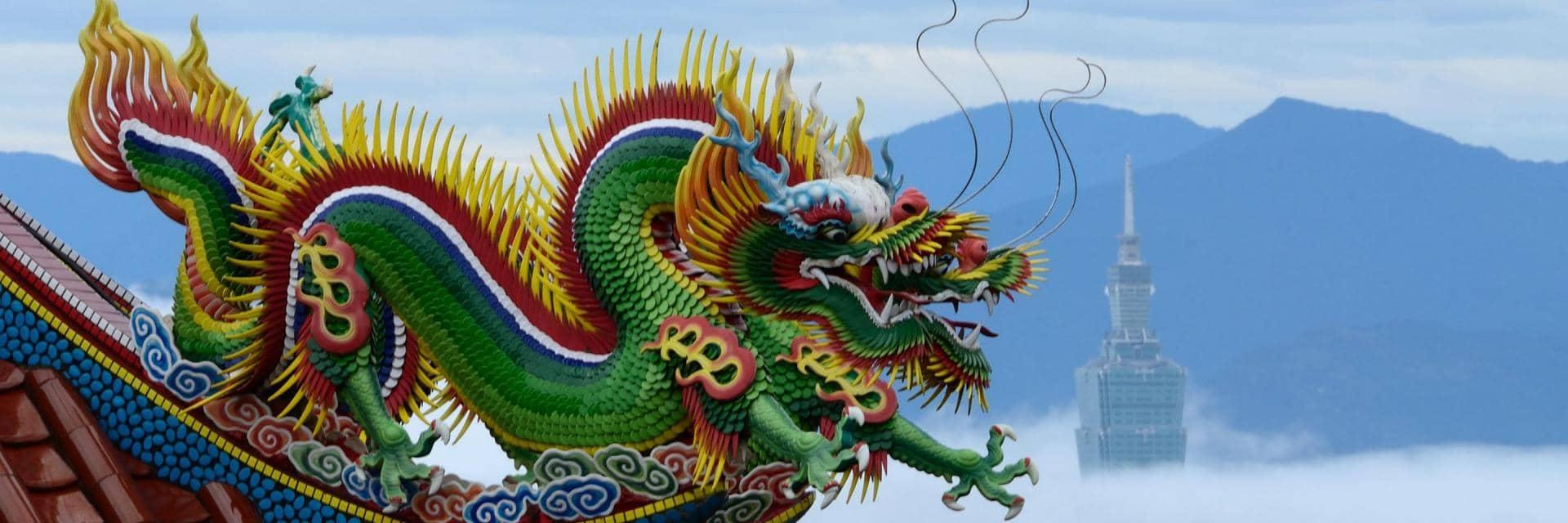
Market Perspectives July 2021
Investor sentiment remains upbeat as signs of inflationary pressures grow. Our investment experts highlight our main investment themes and examine prospects for the global economy.

02 July 2021
By Henk Potts, London UK, Market Strategist EMEA
You’ll find a short briefing below. To read the full article, please select the ‘full article’ tab.
Chinese economic growth leads the pack in the coronavirus era. However, price pressures are rising and domestic demand weakening. Add in US-Sino trading relations and growth may slow sharply this year.
China was the only major economy to generate positive growth, of 2.3% (see table), during 2020, an aggressive response helping it avoid much of the economic impact from coronavirus restrictions. The recovery advanced ahead of its main heavyweight peers, with output surpassing its pre-pandemic level at the end of last year. The early reopening of its economy, rapid industrial production and booming exports resulted in a record breaking annualised growth rate of 18.3% in the first quarter.
| 2020 | 2021F | 2022F | |
|---|---|---|---|
| GDP growth y/y (%) | 2.3 | 8.4 | 5.5 |
| CPI inflation (%) | 2.5 | 1.4 | 2.3 |
| Unemployment rate (%) | 5.7 | 5.4 | 5.2 |
| Consumption (%) | -1 | 5.5 | 3.8 |
Source: Barclays Research, Barclays Private Bank, June 2021
Recent data, however, suggests that China’s ability to maintain its extraordinary growth profile may prove to be a tougher task than some economists have previously projected. Price pressures are rising, domestic demand is struggling to keep pace with exports and policymakers are seeking to cool credit growth, in an effort to avoid financial imbalances.
Manufacturing and exporting lead the recovery
Exports account for around 19% of gross domestic product (GDP) and have been a key driver of growth over the past few quarters. Rising demand has been stimulated by the recovering global economy, coronavirus-related exports (masks and medical equipment) and IT supplies due to more people working from home.
However, export growth slowed in May and missed analysts’ forecasts as supply-chain bottlenecks, record high shipping costs and rising raw material prices started to dampen demand for Chinese products. The strengthening yuan is also likely to exacerbate the easing of export growth in the second half of this year.
The manufacturing the purchasing managers’ index (PMI) remained in expansionary territory in May. But beneath the headline numbers, there were also signs of weakness. The PMI breakdown showed a moderation in new orders, a deterioration in delivery times and a weakening in the employment index.
Price pressures are building
Surging commodity prices drove China’s factory gate inflation in May to the highest levels since 2008. The producer price index surged to 9% year-on-year last month, following a gain of 6.8% in April. Local commodity prices were driven up by stronger global demand as well as domestic hoarding and speculation.
Concerned Chinese authorities are introducing restrictions on commodity trading activities and considering price caps and releasing strategic reserves to improve supply and curb price growth. As the world’s largest exporter, accelerating producer prices in China matters, possibly indicating future global inflationary pressures.
Thus far, producers appear to have been absorbing rising input costs, squeezing margins rather than passing them onto consumers. While, consumer inflation has been picking up from low levels over the past couple of months, May’s headline consumer price index (CPI) print was still relatively subdued at 1.3%.
We forecast that the upward trend in core/services inflation will continue as China gradually lifts COVID-19 containment measures and consumer sentiment improves. CPI is forecast to peak at 2.7% in the final three months of the year (Q4) before easing back to a 2.3% average in 2022.
Softer recovery in consumer spending
The pace of recovery in the service sector and consumption have been more sluggish than previously anticipated. May’s Labour Day holiday spending data showed a pick-up in tourist spending, restaurant bookings and ride-hailing services, but consumer spending was still down 23% on 2019 levels.
It appears that structural factors have been holding back the consumption recovery. House prices in tier one cities have risen by more than 10% over the past year, forcing potential buyers to increase their saving rates to save for higher deposits. Despite improving, urban unemployment is elevated compared to pre-pandemic levels and household real disposable income has not returned to the pre- pandemic growth rate.
As we look into the second half of the year, consumption should benefit from the tailwinds of deferred spending and households’ accumulated savings. The shift in expenditure to domestic markets from overseas, as international travel restrictions remain in place, should boost demand.
Real estate demand remains robust
The Chinese property market staged a V-shaped recovery in 2020. Property investment increased by 7% after 10% growth in 2019. Surging home prices, increased household leverage and concerns about a property bubble encouraged the authorities to introduce a range of tightening measures.
The limiting of mortgage loans and imposing of restrictions on home purchases, among other factors, could infringe on demand. Although, long-term demand for residential property should still be sustained by limited investment channels, slower, but still solid, household income growth and ongoing urbanisation (the urbanisation ratio has increased from 50% of the population in 2010 to 61% in 2019, according to Barclays Investment Bank), limited investment channels and slower, but still solid, household income growth.
Moderating credit growth
Outstanding total social financing, a measure of credit and liquidity in the Chinese economy, has been moderating over the past few months. The slowdown in credit growth can be attributed to a range of factors, including base effects and the impact of tighter credit policy announced in March. Curtailed bank loan growth, reduced government bond issuance, contracting shadow financing and slower corporate bond financing growth are all expected to further reduce credit growth through the second half of the year.
US-Sino relationship remains fraught
The relationship between China and the US remains tense and is a risk to growth prospects. While there are areas of cooperation (such as nuclear non-proliferation and climate change), tariffs, restrictions on dual-use technologies and expanded restricted entities lists will likely remain in place.
The weighted-average tariff on Chinese exports to the US has increased to approximately 19% from around 3% at the start of 2018. China has acknowledged its high-dependence on overseas demand and initiated the “internal circulation” strategy which will see it increasingly focus on domestic production, distribution and consumption to drive growth.
Drifting back to trend growth
China is looking set to cement a remarkable recovery this year with growth of around 8.4%. However, with the comparatives normalising and some clear headwinds developing, it’s perhaps no surprise that year-on-year growth rates appear set to moderate over the next eighteen months.
We predict that the country will drift back towards a “new” trend growth rate of 5.5% in 2022, compared with the almost 10% growth rate achieved by the economy since 1978. Over the coming months we will closely monitor data for signs of deterioration, given China’s influence on global growth and status as a leading indicator of the recovery.

Investor sentiment remains upbeat as signs of inflationary pressures grow. Our investment experts highlight our main investment themes and examine prospects for the global economy.
This communication:
Any past or simulated past performance including back-testing, modelling or scenario analysis, or future projections contained in this communication is no indication as to future performance. No representation is made as to the accuracy of the assumptions made in this communication, or completeness of, any modelling, scenario analysis or back-testing. The value of any investment may also fluctuate as a result of market changes.
Barclays is a full service bank. In the normal course of offering products and services, Barclays may act in several capacities and simultaneously, giving rise to potential conflicts of interest which may impact the performance of the products.
Where information in this communication has been obtained from third party sources, we believe those sources to be reliable but we do not guarantee the information’s accuracy and you should note that it may be incomplete or condensed.
Neither Barclays nor any of its directors, officers, employees, representatives or agents, accepts any liability whatsoever for any direct, indirect or consequential losses (in contract, tort or otherwise) arising from the use of this communication or its contents or reliance on the information contained herein, except to the extent this would be prohibited by law or regulation. Law or regulation in certain countries may restrict the manner of distribution of this communication and the availability of the products and services, and persons who come into possession of this publication are required to inform themselves of and observe such restrictions.
You have sole responsibility for the management of your tax and legal affairs including making any applicable filings and payments and complying with any applicable laws and regulations. We have not and will not provide you with tax or legal advice and recommend that you obtain independent tax and legal advice tailored to your individual circumstances.
THIS COMMUNICATION IS PROVIDED FOR INFORMATION PURPOSES ONLY AND IS SUBJECT TO CHANGE. IT IS INDICATIVE ONLY AND IS NOT BINDING.